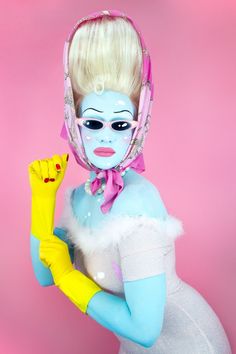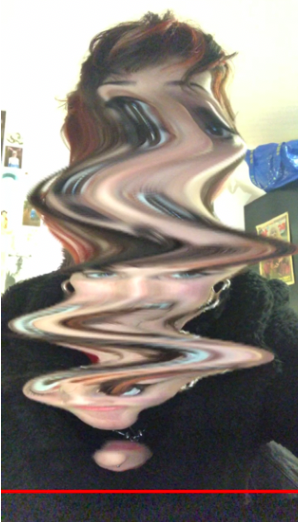Photoshoot/Project Progression:
- Leah Gordon
- Feb 11, 2021
- 7 min read
Updated: Feb 17, 2021
After some deliberation, I've decided that I now don't want to create an installation for the final outcome of this project in particular and instead possibly carry it forward to the final major project so that I have more time to create the items and piece together the work that I want in my installation. However, in a similar vein to what I was considering installation wise, I still want to transform my bedroom space. In a continuation from the neon and bright coloured images I found for the mood board in my installation research post, I thought that I could bring in some retro-futurism and through the lens of looking ahead to the new roaring 20's and imagining a queer utopia, envisaging a possible neo-retro-futurism.
After some further research into queer futurism I came across the artist Jenkin Van Zyl and found this interview with they had with vogue particularly interesting and inspiring:
In the video, Jenkin talks about how Queer people often like to make alter egos and or characters for themselves either to express parts of themselves such as their true gender expression or sexuality, that they may not be able to do otherwise in the outside world; or it can be a very effective way to further express gender and creative expression. This made me think about creating my own otherworldly queer alter ego that would exist in my queer utopia.
Planning/Mood-board:
Below are images that range from 60's film posters to retro futurism imagery all for inspiration for the look of the shoot set and lighting wise, styling wise and how my queer alter ego might look.
Junno Birch:
I've followed the work of Juno birch for a while, but thought she'd be particularly relevant to look at again for this project. She takes a very clever take and twist on retro, particularly 50's and 60's fashion through her drag which through her use of colour and makeup looks like an alien attempting to fit in with 60's society (as she said in the interview below): The way that Birch re-frames this aesthetic and fashion I think is a really powerful comment on femininity and trans-female existences - taking a very stereotypical image of femininity which wasn't accessible to queer and trans folk at the time, and reclaiming it in a modern context. I think it would be really interesting for me to do something similar.
I think definitely after all the retro futurism imagery I have been looking at and how much I enjoy this more queer and playful take on retro fashion that feels so futuristic but also very familiar is definitely the approach I would like to take too.
Leigh Bowery:
I also thought that Leigh Bowery would be really strong to look at for very outlandish and creative gender expression and queer fashion, considering how big he was in the Club Kid scene in the 1980s, which was very much a space for outsiders, in particular to express and celebrate themselves through wonderful fashions and outfits. I particularly like how vibrant Leigh Bowery's outfits were, being really experimental with colour, much like Juno Birch, which gives a very alien feel to his appearance. I also find it really interesting how he morphs and distorts the body through very unusual silhouettes, making him appear very gender ambiguous and almost beyond gender, just a creative, vibrant expression of self.
Photoshoot of my alter ego:
Favourite Pictures from my shoot:
Edits on Lightroom:
Photoshoot evaluation:
Overall, I think that this photoshoot was really successful. The main bulk of it was actually putting together the set and painting myself blue! But I really enjoyed this shoot, not having taking self-portraits for a while and never in this level of characterisation, it was actually really freeing. I created the overlaying effect by having my camera on a really long exposure and as the lens was taking in the light, slowly moving around so it captured multiple angles of my face in one image. I also played around with zooming the lens in and out on a long exposure to create a tunnel effect with the light in some of the photos.
Initial ideas for project outcome:
After retro futurism being such an inspiration for the look of my photoshoot, I thought that the outcome for my project could be a 60's sci-fi inspired film poster but instead advertising a queer utopia.
Here are the main artworks I was using as reference:
My initial attempts on photoshop at creating my own retro futurism inspired font and poster:
I tried to recreate the 60's film poster effect by using a combination of different filters in photoshop and played around with warping and distorting text. I decided to use the text "a friend of Dorothy is a friend indeed" because I thought it was quite clever to use the now rarely used phrase, 'a friend of Dorothy' (a phrase popularised in the 1950's to refer to gay men and LGBTQ+ people) and reclaim it for a queer futurist purpose, especially considering the phrase derives from a film, The Wizard of Oz, and I'm attempting to make a film poster.
However, I think the text is the best bit about these experiments. I tried lots of different options on photoshop but didn't really come out with anything I particularly liked or thought was effective photograph wise. But I'm glad I gave this idea a shot as it allowed me an opportunity to learn a bit ore about how to play around with text and typography in photoshop, something I can definitely bring into future projects.
Where to next?
I wanted to come back to my ideas at the start project about imagining what the new roaring 20's could look like. In a conversation with a peer about this project the idea of Cyber feminism, in particular Glitch Feminism and Xeno Feminism came up, and after they educated me further on these branches of feminism and artworks surrounding these groups, that further research into this area could be really beneficial for this project.
Xenofeminism (XF) --> is a gender abolitionist, anti-naturalist, technomaterialist form of posthumanism, initiated by the working group Laboria Cuboniks. It is a world-building project working from the assumption that any society worth constructing would take feminism as a foundational principle. It is a project that aims to infect a wide range of fields, and operates on the assumption that any meaningful change will happen at a range of scales and across a range of disciplines.
Glitch Feminism --> is a manifesto for cyber feminism, explained in the book Glitch Feminism by Legacy Russell which is described as being a 'new chapter in cyberfeminism, one that explores the relationship between gender, technology and identity. In an urgent manifesto, Russell reveals the many ways that the glitch performs and transforms: how it refuses, throws shade, ghosts, encrypt, mobilises and survives.'
Glitch Feminism and XenoFeminism are very LGBTQ+ and POC inclusive branches of feminism who both discuss the relationship between gender and technology and what technological progression means for gender, hence why I thought they would be so relevant to this project.
^^Above is a lecture I watched about Xenofeminism which discussed the idea of the body being technology and how gender may be understood as a workplace technology, a labour saving device.
Although heavily intrigued by the subject matter, I found myself being mainly interested by the fact that the two speakers presented the lecture wearing digital masks which, particularly the one worn by Helen Hester, I found really beautiful and to me allowed a brief look into the future.
These digital masks made me think about what the progression from lenses and filters on social media apps could look like if they became physically accessible, not just virtually. It also lead me to think about how despite optimism, I don't think my idea of queer utopia, a world free of prejudice, oppression, gender stereotypes and a genderless society will be achieved anytime soon, so the opportunity that said possible holographic masks could create for queer people to further realise their queer expression and or express any characters or alter egos they've created either online or through drawings etc. could be really beneficial in terms of alleviating gender dysphoria for trans people and existing as a further form of escapism, much the same as drag and drag performances do.
In the vain of my very alien, retro futurism inspired photoshoot and research earlier on, I wanted to see what sci-fi and fantasy filters were available to me on my phone. Also after doing the anti-practice workshop it's really made me much more aware of ways that I could push my photography, in this case using a non-traditional photography method.
Here are some I found and played with on Instagram:
Playing with filter photos on photoshop:


Experimenting with these filters and the actual outcome of playing with your appearance on social media made me think that I'd like to create my own gender morphing, alien inspired mask specifically aimed towards queer people.
Although I don't think its possible that I'll be able to learn how to do this for this project in particular, its definitely an interesting idea that I could take forward. It also made me think about where the future of photography, especially the areas of portraiture and fashion photography, are headed as technology continues to evolve and our relationship with it changes. I think it would be really interesting to continue looking at alternative methods of photography and trying myself to create what photography in the future could look like.
Evaluation:
Overall, I'm pretty happy with how this project turned out. Although in hindsight, and after peer review it seems quite disjointed, with my ideas for where I wanted to the project to end up constantly changing, I think that it was actually really beneficial for me to be so open to ideas and different outcomes, considering non traditional photographic means and thinking about exploring avenues I've always wanted to but never really had the chance. I definitely want to take a lot of my ideas forward from this project into the final major project, particularly the installation and digital mask concepts that I never ended up actually fulfilling. I would also like to take it as an opportunity to do further research into queer theory and queer artists, as that's something I've really enjoyed doing for this project and definitely think that's a lot more to learn, discover, and create about. I found this project difficult in parts; not understanding all the different workshops we were doing, which felt counter productive to me at points, but I think the heightened awareness of other pathways because of these zooms actually turned out to be very constructive in the end as it made me consider a wider range of techniques, mediums and outcomes that I wouldn't have done otherwise. As well as the subject matter, I'd also really like to take forward this appreciation for experimentation that I've found and really seen the value in, especially in the project. Staying on top of my work is also something I did pretty successfully for this project, and that's definitely something I would like to continue.




























































































































































































































































































Comments